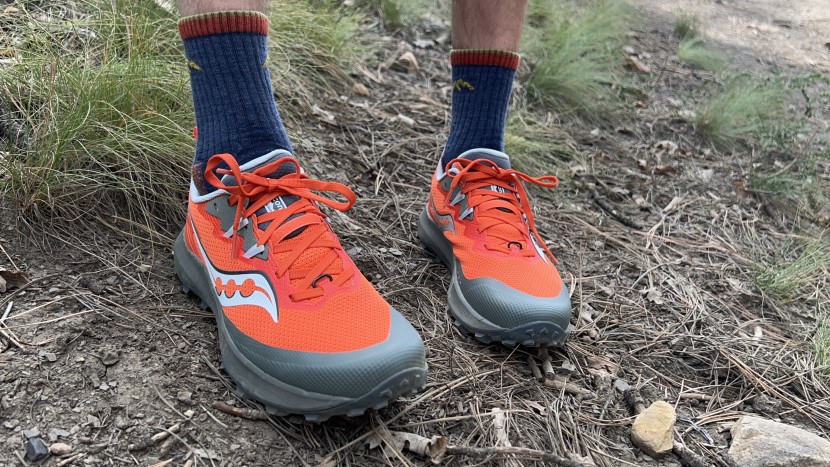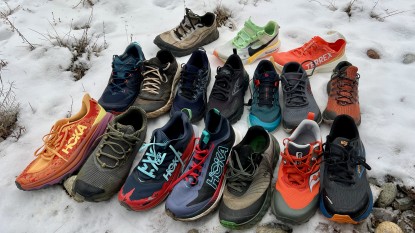Saucony Peregrine 14 Review
Our Verdict
Compare to Similar Products
 This Product
Saucony Peregrine 14 | |||||
|---|---|---|---|---|---|
| Awards | Best for Long Distance Trail Runs | Best Value Men's Trail Runners | |||
| Price | $112.59 at Amazon Compare at 3 sellers | $145.00 at REI Compare at 3 sellers | $130.00 at REI Compare at 2 sellers | $110 List $109.95 at Amazon | $80 List $59.95 at Amazon |
Overall Score  |
|||||
| Star Rating | |||||
| Bottom Line | We continue to wish the outsole was a bit stiffer to increase confidence in fast technical scenarios, but we appreciate the agility of this lightweight model | While comfortable, sometimes the heel rigidity felt overbearing, but this is still a great option for technical terrain | This version's upper fit is narrower, which adds more technical performance but may feel tighter than some like | While great in moderate terrain those in technical or loose may opt for something more rugged | More serious runners should opt for a shoe with a better midsole |
| Rating Categories | Saucony Peregrine 14 | La Sportiva Bushido... | Hoka Torrent 4 | Brooks Divide 5 | Asics Gel-Venture 9 |
| Foot Protection (25%) | |||||
| Traction (20%) | |||||
| Sensitivity (15%) | |||||
| Stability (15%) | |||||
| Comfort and Fit (15%) | |||||
| Weight (10%) | |||||
| Specifications | Saucony Peregrine 14 | La Sportiva Bushido... | Hoka Torrent 4 | Brooks Divide 5 | Asics Gel-Venture 9 |
| Sizes Available | 7 - 15 US regular 7 - 15 wide |
6 - 14.5 US regular and wide | 7 - 15 US regular |
7 - 15 US regular |
7 - 15 US regular |
| Measured Heel Stack Height | 30 mm | 30 mm | 31 mm | 38 mm | 36 mm |
| Measured Heel-to-Toe Drop | 3 mm | 8 mm | 5 mm | 11 mm | 11 mm |
| Rock Plate | Yes; unknown material | 1.5mm EVA | No | No | No |
| Measured Lug Depth | 4.9 mm | 4.2 mm | 4.32 mm | 2.79 mm | 3.18 mm |
| Measured Weight | 10.10 oz | 11.60 oz | 9.40 oz | 10.55 oz | 11.82 oz |
| Upper | Mesh | AirMesh, thermal adhesive microfiber, high-frequency welded ripstop overlays with mono-burr mesh inlays, TPU toe cap | Single layer mesh upper | Mesh | Mesh |
| Midsole | PWRRUN cushioning | 4mm LaSpEVA, compression-molded MEMlex, 1.5 mm dual-density compressed EVA rock guard in forefoot, TPU STB inserts | Foam | Foam | AMPLIFOAM™ cushioning |
| Outsole | PWRTRAC rubber outsole | Bi-Compound FriXion XT 2.0 V-Groove3, FLEX Inserts | Rubber | Rubber | Rubber |
| Heel Tab Type | Finger Loop | Finger Loop | Finger Loop | None | Finger Loop |
| Claimed Heel-to-Toe Drop | 4 mm | 6 mm | 5 mm | 8 mm | 10 mm |
Our Analysis and Test Results
The Saucony Peregrine 14 provides a ton of comfort in such a speedy model. Sometimes the outsole falls short on mixed terrain, and we think Saucony could stiffen the midsole ever so slightly to boost confidence when really running hard. However, this still is a model we love, offering excellent cushioning while remaining light and lively.
Foot Protection
The cushioning found on the Peregrine 14 is less stiff than some of the competition in its weight class. This gives less underfoot protection as rocks are more likely to protrude underneath the forefoot and midfoot when landing. The thin fabric rock plate helps reduce any hard impacts, but rocks and trail debris are more noticeable. This shoe's stack and general feel lead to great sensitivity, so we actually don't mind this lower protection. The upper still provides durability from the elements, and the toe cap does a great job of deflecting accidental toe bumps.
Traction
We continue to wish Saucony would opt for a slightly harder rubber compound for the outsole of the Peregrine series. While it's perfectly adequate for most situations, it lacks a bit of grip in speedy technical terrain, and we think the increased hardness would add a bit more confidence. We also think Saucony should cover up the exposed foam on the outsole to improve durability. The 4.90 mm lugs do a pretty good job in wet environments due to their softness, but we did find that they picked up dirt, creating a bit of slippage when transitioning back to dry rock. If you are running mostly in dry environments like our lead tester, Matthew, you could potentially want a harder rubber compound. For more mixed climates and variety, the Peregrine feels secure and sure-footed.
Sensitivity
The Peregrine 14's strongest attribute is sensitivity, which made it a joy to run in. Challenging terrain felt precise and effortless, and the feedback to the brain made running fun and enjoyable. We loved this for everything from hiking to tempo efforts. Great ground feel does come with some downsides as, over time, fatigue can start to set in with a lack of supportive features. If your daily runs are somewhere in the 2-hour range or for extended periods at lower efforts, this could be the perfect addition to your rotation.
Stability
With a claimed heel drop of 4 mm (we measured 3 mm) and a stack of 30 mm in the heel, the Peregrine provides good stability even with the very comfortable foam. The lack of stiffness through the outsole and midsole does provide all-day comfort but reduces the stability from the ankles, through the knees, and up through the hips. We really never felt hindered by the comfort of the stability, but if you are looking for additional rigidity and a solid locked-in feel, you should look elsewhere. For a shoe this light and agile, we think Saucony did a great job combining support and comfort without reducing the lively, free nature of the model.
Comfort and Fit
The Saucony Peregrine 14 is comfortable yet playful on even the most challenging and technical courses. We wouldn't pick this model for speed during races, but for a downright enjoyable feeling while you run, this is one of our favorites. With a traditional upper, the shoe fits snugger than some of the wider competition and has a solid lockdown. The padded tongue reduces any conflict with the laces, and the toe bumper provides protection against impact. For lighter runners, you could even consider this an everyday trainer due to its comfort — we even know some users that have used it for hundreds of miles on their thru-hikes. Heavier runners may want some increased support and could find the foam too compressive for technical terrain, but the Peregrine 14 us strikes a largely perfect middle ground when it comes to comfort.
Weight
While not the lightest, at 10.10 ounces per men's US size 10.5, the model's lower stack and drop make it seem quicker than its weight would suggest. Saucony doesn't cut unnecessarily here and manages to maintain a durable upper and comfortable tongue padding. While the model lacks superlight materials, the overall shoe speaks of quality. We've always been impressed with Saucony's value and design. As longtime fans of the road Kinvara series, we continue to be impressed with the similarities of the Peregrine series. For smooth, light comfort on and off the trail, the weight won't hold you back.
Should You Buy the Saucony Peregrine 14?
If you are most interested in lightweight comfort and don't need the latest in tech-focused uppers, this shoe is a great option for you. With a touch of added stiffness, we feel this shoe could be a bit more responsive. While it never feels slow, on open straights and less technical running, the shoe could feel snappier. The Peregrine 14 excels in technical terrain with mixed conditions and is a favorite of ours for all-day, lightweight comfort. For race-style efforts, you may want to opt for something with more stiffness for its added support. We recommend the Peregrine for extended hikes and consistent runs shorter than 20 miles.
What Other Trail Running Shoes Should You Consider?
The Nnormal Kjerag offers the same level of performance and impressive comfort but a higher energy transfer if you want to go faster. The Hoka Torrent 4 is a stiffer model that's a bit more directional in its performance but still lively underfoot. If you're after max comfort but still desire technicality, we'd suggest Nnormal Tomir 2.0.














